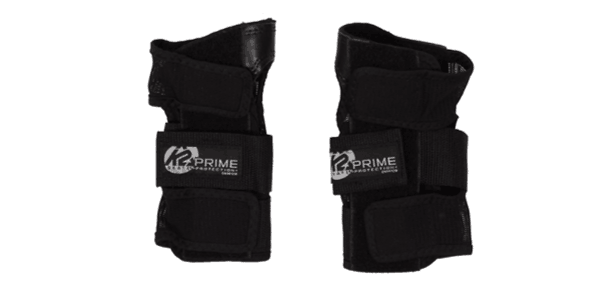I have worn wrist guards in the past and heard stories that they’re dangerous so I wanted to get to the bottom of this to pass on the best advice.
So, are wrist guards safe? In short, it appears they do a good job of preventing wrist injuries that are extremely common in activities like rollersports, skateboarding, and snowboarding. Claims they send the injury “up the arm” may be based on very severe falls, and there is very little evidence at the moment to suggest they result in other non-wrist injuries. They are safe and helpful.
So, why are people suggesting they don’t help, and is this 100% rubbish?

Do Wrist Guards Actually Work?
Wrist injuries are one of the most common injuries in inline skating, roller skating, skateboarding, and snowboarding (though not skiing, where most are to the knees). People put out their hands to break a fall — as you would — and hit the surface with a hard enough impact to bruise, tear ligaments, and dislocate or fracture the wrist.
Wrist guards use moulded plastic over the front and back of the wrist that absorb some of the impact, limiting the range of motion of the wrist to prevent the wrist from bending too far backwards, and helping it slide along the floor when you fall. Because your wrist slides, there’s less weight pushing the hand into the ground.
Just like you wouldn’t expect your helmet to protect your knees, wrist guards provide no protection for other areas like upper arms or shoulders.
Researchers have tested whether they work. They fitted wrist guards to severed cadaver arms (yes, severed arms of the dead). They had to drop them from higher, and more times, to damage the wrist when they were fitted with wrist guards.
One study found the use of any guard reduced peak impact forces by a minimum of 31.8% in an artificial set up.
Another study found less severe injuries in those wearing wrist guards, concluding:
“Wrist guards and elbow pads are effective in protecting in-line skaters against injuries”
Original Study
Skaters in an accident involving the wrist were almost 13 times more likely to get a wrist injury if they weren’t wearing them.

Another pertinent fact to this question:
There is a European standard for inline skating wrist protectors (EN 14120)
This involves the testing of the equipment. Without saying much more, we can say that engineers have looked to construct them to work, and that they have considered the body’s physiology when making them.
Is There A Danger They Just “Move The Break” Up The Arm?
In the community of skaters, skateboarders and snowboarders there’s been the perception that wrist guards “move the injury” from the wrist up the arm. There are few studies that look at this explicitly and the advice from professionals seems to be that it might be in these cases the injuries sustained were down to bad falling, or very severe falls which would have been worse without the wrist guard in place.
However, one report looked at case studies in snowboarders and concluded that the use of wrist guards while reducing the risk of hand, wrist and forearm injuries may indeed increase risk of elbow, upper arm and shoulder injuries.
But currently the jury is still out as another study found a protective effect on shoulder injuries. There is also slight evidence they could increase the risk of finger injury in snowboarders
Another expert in the field, reported that a splint that is too stiff could cause a broken elbow instead of a broken wrist as the shock would transfer along the lower arm in a bad fall. Notably this is referring to snowboarders, not inline skaters, whose falls may more often occur at higher speeds in different conditions.
When it comes to inline skating, one case study report on “splint top” fractures looked at fractures seen at the border of the wrist splints, suggesting the wrist guard to be the cause.
Note that these studies aside, wrist guards are still considered a very good idea because of the high incidence of wrist injuries in inline skating and their ability to protect against them, with only a tiny minority of cases suggesting they “moved the injury”.
Do I Need To Wash The Wrist Guards?
If you sweat while you wear wrist guards, this means bacteria will be growing within them. They may indeed start to smell. So you will need to check the specific wrist guard for working out how to wash it, but you can probably stick it in the washing machine no issue.
Who Should Wear Them?
The most typical falls involve young novices or beginner skaters who either lose balance or trip over a road defect or debris. These falls occur on outstretched arms and the wrist is the most common site of primary injury (32%), with 25% of these wrist fractures.
It seems to be an especially good idea to wear wrist guards if you are a beginner because the one thing they are designed to prevent, is what you’re most at risk of.
But overall, even if you are not a beginner, the benefits are still there.
What Types Of Wrist Guards Are There?
There are several types depending on your definition. Some for inline skating and roller skating, and some specialised for snowboarders.
Some wrist guards have a single “splint” on one side, which if on the palm side functions to absorb impact, and some have double splints which includes one on the top hand side which prevents the wrist from bending back too far.
It is a trade off for comfort and safety, where the double splint offers the most protection to the wrist itself (though not to other parts of the body of course) but limits movement.
Real basic ones are gloves with a wrist strap – these should not really be considered wrist guards because they don’t have the plastic support which is the main functional component. They will do little else than protect your palm from grazing when you fall. Better than nothing, but not really any protection for the wrist.
The wrist guards for inline skating have a strap around your wrist and a plastic bent bit in front of your wrist.
Wrist guards are not to be confused with wrist braces, which is an injury recovery device.
More extensive versions are available in snowboarding, specifically made for that sport. There is a difference in their construction which according to the engineers is based on how the participants fall. See more for that in “how do they actually work?” below.
Watch here a video on snowboard wrist guards, which includes the skating variety.
What Are Level 1 And Level 2 Wrist Guards?
Wrist guards are rated by level, with level 1 being low profile pads designed for partial impact proection and a good range of motion, and lighter, and more comfortable. These are recommended for all levels, including recreational, urban, fitness, marathon, as well as dance and slalom.
Level 2 have extended surface area providing coverage beyond the point of impact, with larger straps, some have sleeves, and they keep the pads better aligned, padding size is increased, larger size can limit range of motion, make them warmer to wear. These offer more protection, may be good for beginners or those who know they’re going to fall, like some aggressive skaters.
How Many People Actually Wear Wrist Guards?
It depends where you go, but they seem fairly popular out of safety equipment.
In Ontario Canada (in 1999) wrist guards were the most common protective equipment (25%) followed by elbow pads (14%), helmets (13%), and knee pads (10%)
In Boston, in 1997, about 60% of inline skaters worse wrist guards, with only 5.7% wearing helmets. (interestingly, males wore less than females). Beginners and advanced wore more protective gear than average skaters, street skaters wore the least.
Protective gear use and skating location by sex
| Male (%) | Female (%) | Everyone (%) | |
| What gear? | |||
| Helmet | 5.6 | 5.9 | 5.7 |
| Elbow pads | 9.3 | 11.4 | 10.0 |
| Knee pads | 20.1 | 28.6 | 22.8 |
| Wrist guards | 54.7 | 73.2 | 60.5 |
| What location? | |||
| Street | 13.3 | 7.6 | 11.5 |
| Sidewalk | 15.4 | 14.8 | 15.2 |
| Bike path | 71.2 | 77.5 | 73.2 |
How Do Wrist Guards Actually Work?
Wrist guards work because when your wrist impacts the surface, the plastic guard helps by performing a couple of important functions:
According to research, during low energy falls wrist guards work by sharing the load and absorbing impact energy.
As mentioned above, preventing the wrist from bending too far backwards, allowing the wrist to slide, and absorbing the brunt of the force, they reduce the strain on bones.
One team found injuries for skateboarders on concrete or tarmac break their wrists lower down than snowboarders which occur higher up the arm, because when they fall on the snow there is more hyperflexion of the list being lifted.
Wrist guards are thus designed differently for inline skaters and snowboarders. Wrist protection for inline skaters are stiff and short, and on the palm side, whereas snowboarders is on the other side to protect hyperinflexion. These plastic materials are strong but not too stiff, and cushioned against the skin by softer materials such as cotton and lycra.
When Should I Not Wear Wrist Guards?
It might be questionable whether they are a good idea in every sport, especially those that require grip.
Some evidence suggest wearing wrist guards could potentially increase fall related injuries to non-protected body areas if used for children playing on climbing apparatus like monkey bars. Similarly with children riding the bicycle losing their line of steering possibly due to loss of dexterity.
So, it does depend on who you are and what you’re doing.
Again, we come back to inline skaters of all types.
What’s The Recommendation With Wrist Guards And Why?
Because wrist injuries are so common in skating, wrist guards are generally recommended for most use, and especially for beginners whose most common injuries are prevented well by them.
Other Related Questions
How do wrist guards go on? Inline wrist guards typically slip over the wrist with the bended bit of plastic on the palm side so that it sticks out towards the ground on a fall, meaning it absorbs the impact (instead of your hand and wrist).
How much are wrist guards? Wrist guards vary from around £11 to up to £50.

